Hello Art lovers, Festive season are coming and on this Diwali, I am very excited to share with you all, this art creation. Come and join we will enlighten our home with our very own hands.
Diwali is the time of the year when we indulge in enjoying various types of activities, from decorating your house to making lip-smacking festive food! During this season, decorative items for your humble home or for gifting purposes can undoubtedly make the festival of lights more memorable. Investing in art is a wonderful way of passing on sentiment, giving them something that they’ll cherish for a lifetime.
Homes demand a colourful and bright transformation during the festive season. Bring home the era of the artful with meaningful decor pieces, traditional crafts and lots of bright colours. All one needs is to curate a mood board that is timeless and ever-festive.
Indian crafts have long lent expression and meaning to home decor. The art of creating contemporary designs has global influences. Pairing traditional pieces with modern designs is the core secret of a festive season.
RANGOLIS
Rangoli is an art form originating in the Indian subcontinent, in which patterns are created on the floor or a tabletop using materials such as powdered lime stone, red ochre, dry rice flour, coloured sand, quartz powder, flower petals, and coloured rocks. It is an everyday practice in Hindu households, however the colours are preferred during festivals and other important celebrations as it is time consuming. Rangoli are usually made during Diwali or Tihar, Onam, Pongal, Sankranthi and other Hindu festivals in the Indian subcontinent, and are most often made during Diwali.
Rangoli designs can be simple geometric shapes, depictions of deities, or flower and petal shapes appropriate to the given celebrations. They can also be made with elaborate designs crafted by numerous people.
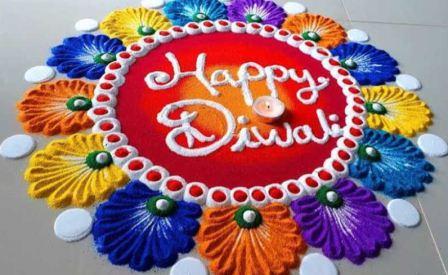
In middle India mainly in Chhattisgarh Rangoli is called Chaook and is generally drawn at the entrance of a house or any other building. Powdered quartz, dried rice flour or other forms of white dust powder is used for drawing Chaooks. Although there are numerous traditional Chaook patterns, many more can be created depending on the creativity of the person who draws it. It is considered auspicious as it signifies showering of good luck and prosperity on the house and in the family. It is not drawn like a Bloke picture. Patterns are created based on certain systems. Generally, women get up early in the morning and clean the area just outside the entrance of their houses with cow dung, sprinkle the area with water and draw the Chaook. In Maharashtra and Karnataka, rangoli are drawn on the doors of homes so that evil forces attempting to enter are repelled.
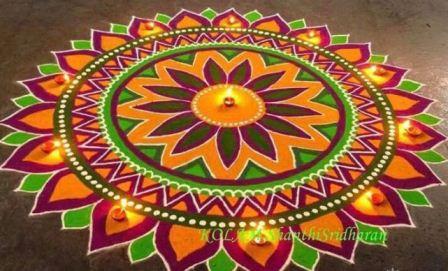
During the festival of Onam in Kerala, flowers are laid down for each of the ten days of the celebration, the design growing larger and more complex every day. In Tamil Nadu, Andhra Pradesh and Karnataka, and many parts of Maharashtra, the rangoli or Kolam is drawn upon the ground or floor daily. The designs are geometric and symmetrical shapes but the materials used are similar rangoli: powdered quartz, rice flour or slurry is used. In Rajasthan the Mandana are painted on walls. Mmandne, various festivals, major festivals and can be categorized based on seasons. Different shapes depending on the size of it also can be shared. Kumaon’s “writing beat ‘or in a variety of plotting symbols Thapa, artistic designs, Bellbutoan is used. Alikhthap of society apart – separated by different groups – different icons and art media is used. In Odisha, the Murja is put at the aangan of every home in front of the Tulsi plant called “Tulasi chahura”. The rangoli patterns mostly are dedicated to Lord Krishna and Lord Jagannath. The Murja festival is observed during the auspicious month of Kartika ending on Kartika Purnima.
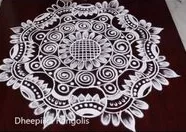
Shape, design and material can be influenced by regional traditions. A square grid is common in North India as is a hexagonal grid in South India; Onam Rangoli is typically circular. In North India, the colour is most often based on gypsum (chirodi), in South India on rice flour and Onam Rangoli are typically flower based. The rapid and widespread migration and mixing of people within India can be seen by the way these styles are now freely adopted and mixed across the country. It is also becoming common to see experimentation like sawdust-based floating rangoli, freeform designs, and exotic materials.
During the festive season be it Dussehra or Diwali, decorating our homes with toran and rangolis besides lights, is a given. So if you are hunting for some different designs to make your home stand out or to simply push your creative boundaries, then these different kinds of designs executed in a unique way will be a hit!.
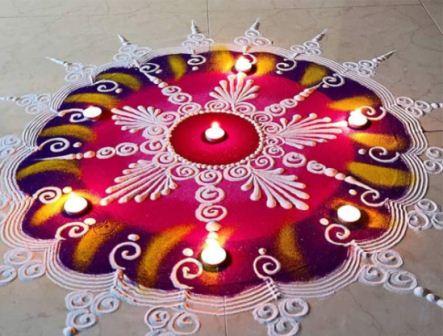
Terracotta pottery
The making of terracotta pottery is no ordinary process. Each terracotta pot or piece of art is created by a fascinating process with grace and dedication and the time taken to make such a masterpiece is what makes terracotta so valuable and expensive.
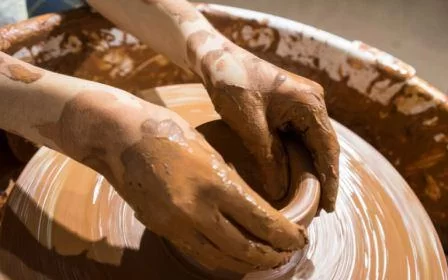
How it is made ?
Terracotta means “baked earth” in Italian. Terracotta is the type of clay used to produce terracotta pottery on a potter’s wheel. The potter at a full tilt rotates the wheel with his hands and gives the ball of clay a shape. The pot or object, after being left to dry is kept on top of combustible materials in a pit and fired. Mostly charcoal, wood or coconut shells are used for firing and the temperatures may range from 600 to 1000 deg C. The process is complete only after the pottery has been baked for more than two hours to ensure it is hard, strong and durable.
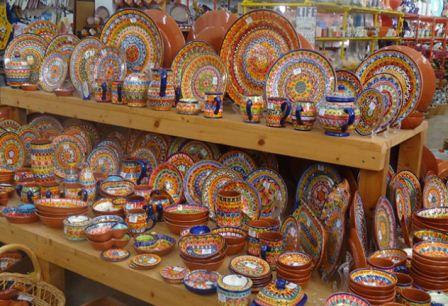
Even then, given the nature of the clay, terracotta pottery is porous and water can seep through these pots. However, a coat of glaze can fix that, making the pots water tight. Thus, terracotta is usually of two types, glazed and unglazed. The glazed pots are easy to clean and food gets cooked evenly in them. However, numerous benefits are lost, like the maintenance of the acid-alkaline balance as well as the earthy flavour that unglazed terracotta adds to the food.
Terracotta is usually reddish or brown in colour and is considered to be the first ingenious expression of civilization. From the small earthen pots in which we store water to the giant-sized cultic equestrian figures of the rural Tamil deities of the Aiyanar cult, terracotta art occupies a consequential place in Indian life and culture. It has broken all the principles of Shilpa-sastra or sculpting and gives itself enormous freedom in terms of imagination and conception, allowing the potter to translate his emotions and thoughts into a work of art.

There’s a potter’s wheel where you can make your own pot and take it back home and there’s handmade ceramic art, jewellery, murals, sculptural artwork, and even home decor to be picked up.
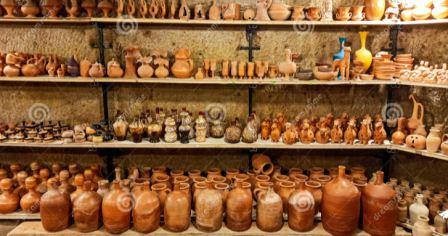
Blog By :
Dr. Ramakant Gautam
Assistant Professor
Department of Social Science (Visual Arts)
Biyani Group of Colleges

